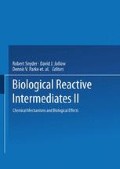Abstract
When we began our studies about six years ago on the relationship between the metabolism and hepatotoxicity of trichloroethylene, there seemed to be a great deal more to know about its mechanism of metabolism than about its hepatotoxicity. Knowledge about its metabolism began with the detection by Powell in 1945 of an oxidized metabolite of trichloroethylene with three chlorines on one carbon in human urine. On this basis, she suggested that the metabolism of trichloroethylene proceeds via an unstable epoxide intermediate. Subsequently Daniel (1963) demonstrated that the oxidation of trichloroethylene to trichloroethanol and trichloroacetic acid proceeds without loss of labeled chlorine, which supported an epoxidation mechanism of metabolism followed by an intramolecular chlorine shift. Metabolic investigations by Leibman (1965) identified the liver mixed-function oxidases as the enzyme system primarily responsible for the initial oxidation of trichloroethylene. Other enzyme systems, including those in the adjacent cytoplasm, were found to participate in subsequent hydration, oxidation, reduction, and/or conjugation of secondary metabolites (Byington and Leibman, 1965; Muller et al., 1975). Figure 1 summarizes probable and potential pathways of trichloroethylene biotransformation.
Supported by Grant No. ES-02102 from the National Institutes of Health.
Access this chapter
Tax calculation will be finalised at checkout
Purchases are for personal use only
Preview
Unable to display preview. Download preview PDF.
References
Byington, K. H. and Leibman, K. C., 1965, Metabolism of trichloroethylene in liver microsomes II. Identification of the reaction product as chloral hydrate, Mol. Pharmacol., 1: 247.
Carlson, G. P., 1974, Enhancement of the hepatotoxicity of trichloroethylene by inducers of drug metabolism, Res. Commun. Chem. Pathol. Pharmacol., 7: 637
Daniel, J. W., 1963, The metabolism of 36Cl-labeled trichloroethylene and tetrachloroethylene in the rat, Biochem. Pharmacol., 12: 795.
Henschler, D. J. and Bonse, G., 1977, Metabolic activation of chlorinated ethylenes: Dependence of mutagenic effect on electrophilic reactivity of the metabolically formed epoxides, Arch. Toxicol., 39, 7.
Leibman, K. C., 1965, Metabolism of trichloroethylene in liver microsomes I. Characteristics of the reaction, Mol. Pharmacol., 1: 239.
Leibman, K. C. and McAllister, W. J., 1967, Metabolism of trichloroethylene in liver microsomes. III. Induction of the enzymatic activity and its effect on excretion of metabolites, J. Pharmacol. Exp. Ther., 157: 574.
Moslen, M. T., Reynolds, E. S., Boor, P. J., Bailey, K., and Szabo, S., 1977, Trichloroethylene-induced deactivation of cytochrome P-450 and loss of liver glutathione in vivo, Res. Commun. Chem. Pathol. Pharmacol., 16: 109.
Moslen, M. T., Reynolds, E. S., and Szabo, S., 1977, Enhancement of the metabolism and hepatotoxicity of trichloroethylene and perchloroethylene, Biochem. Pharmacol., 26: 369.
Muller, G., Spassowski, M., and Henschler, D., 1975, Métabolism of trichloroethylene in man III. Interaction of trichloroethylene and ethanol, Arch. Toxikol., 33: 173.
Powell, J. F., 1945, Trichloroethylene: Absorption,-elimination and metabolism, Br. J. Ind. Med., 4: I42.
Reynolds, E. S. and Moslen, M. T., 1977, Damage to hepatic cellular membranes by chlorinated olefins with emphasis on synergism and antagonism, Environ. Health Perspect., 21: 137.
Reynolds, E. S., 1977, Liver endoplasmic reticulum: Target site of halocarbon metabolites, Adv. Exptl. Med. Biol., 84: 117.
Author information
Authors and Affiliations
Editor information
Editors and Affiliations
Rights and permissions
Copyright information
© 1982 Springer Science+Business Media New York
About this chapter
Cite this chapter
Reynolds, E.S., Moslen, M.T. (1982). Metabolic Activation and Hepatotoxicity of Trichloroethylene. In: Snyder, R., et al. Biological Reactive Intermediates—II. Advances in Experimental Medicine and Biology, vol 136. Springer, New York, NY. https://doi.org/10.1007/978-1-4757-0674-1_51
Download citation
DOI: https://doi.org/10.1007/978-1-4757-0674-1_51
Published:
Publisher Name: Springer, New York, NY
Print ISBN: 978-1-4757-0676-5
Online ISBN: 978-1-4757-0674-1
eBook Packages: Springer Book Archive

